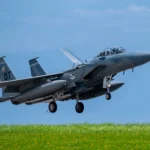Recent reports indicate that Russia has begun modifying its military reconnaissance drones with auxiliary fuel tanks to extend their range for incursions toward NATO territory—specifically Poland. This development underscores a shift in Russian UAV tactics and highlights the increasing use of unmanned systems for probing NATO airspace and testing regional defenses.
Extended-Range Russian Drones Launched from Kaliningrad
According to open-source intelligence and regional defense officials cited by UAS Vision and corroborated by other defense monitoring platforms, Russian drones launched from the Kaliningrad exclave have been observed flying extended routes toward Polish airspace. These unmanned aerial vehicles (UAVs), reportedly of both fixed-wing ISR configurations and smaller FPV types adapted for longer endurance, were equipped with external or modular auxiliary fuel tanks to significantly increase flight time.
Kaliningrad’s proximity to the Polish border—less than 100 km in some areas—makes it an ideal launch point for such operations. However, the addition of extra fuel capacity suggests Russia is testing longer loiter times or more complex flight paths designed to evade radar detection or exploit gaps in NATO’s integrated air defense systems (IADS).
Likely Platforms Involved: Orlan-10 and ZALA-Derived Systems
The specific drone models used in these missions have not been officially confirmed. However, based on visual evidence and flight characteristics reported by Polish authorities and OSINT groups such as Tatarigami_UA and Oryxspioenkop, the most likely candidates include:
- Orlan-10: A staple of Russian tactical ISR operations since 2014. It has a baseline range of ~120 km but can be extended with modified payloads or fuel modules.
- ZALA 421-16E5 or ZALA Lancet variants: While Lancet is typically a loitering munition, ZALA’s fixed-wing reconnaissance platforms are known to be modular and may accept additional fuel loads.
The use of these systems aligns with Russia’s broader doctrine of persistent surveillance along contested borders using low-cost UAVs that are difficult to detect due to their small radar cross-section (RCS) and low acoustic signature.
Tactical Objectives: ISR Probing and EW Testing
The incursions appear to be primarily intelligence-gathering missions rather than kinetic strikes. Polish military sources suggest that the drones are mapping electromagnetic signatures (SIGINT/ELINT), testing GNSS spoofing resilience in NATO-aligned airspace, or observing troop movements near forward-deployed units.
This aligns with past Russian behavior along NATO borders where UAVs are used as low-risk tools to test response times from Integrated Air & Missile Defense (IAMD) assets like NASAMS or Patriot batteries stationed in eastern Poland. Additionally, extended loiter time allows these drones to collect multi-sensor data over a wider area—potentially including EO/IR imagery of logistics hubs or rail nodes critical for NATO reinforcement plans under Operation Atlantic Resolve.
NATO Response: Increased Air Policing and EW Countermeasures
NATO member states bordering Kaliningrad—including Poland, Lithuania, and Latvia—have responded by increasing readiness levels among quick reaction alert (QRA) fighter detachments under Baltic Air Policing missions. Additionally:
- EW units near Suwałki Gap have reportedly begun deploying mobile jammers capable of disrupting C2 links between ground stations in Kaliningrad and inbound UAVs.
- Polish Armed Forces have invested further into counter-UAS systems such as SkyCtrl anti-drone guns and radar-cued optical tracking systems deployed at key installations.
- NATO AWACS flights, particularly E-3 Sentry aircraft operating out of Geilenkirchen AB (Germany), have increased patrol frequency over northeastern Poland since mid-2024.
Implications for Regional Security Posture
The use of modified long-range drones by Russia represents a cost-efficient way to exert pressure on NATO without overt escalation. Unlike manned aircraft incursions—which risk direct confrontation—UAV probes offer plausible deniability while still collecting valuable data on adversary readiness levels.
This tactic also mirrors similar patterns seen elsewhere—in Syria against U.S. forces at al-Tanf garrison using Iranian-designed Shahed-series drones; or over the Black Sea where MQ-9 Reapers were harassed by Russian fighters during ISR missions. The trend indicates growing normalization of unmanned “gray zone” operations below Article V thresholds but with strategic impact.
Future Outlook: Drone Hardening vs Drone Saturation
If current trends continue, NATO may need to consider more robust counter-UAS layers beyond point defense systems. This could include:
- C-UAS integration into IADS networks: Ensuring that drone detection is fused into existing radar tracks shared via Link-16 or STANAG protocols across allied forces.
- Saturation scenario planning: Preparing for mass drone swarms launched from Kaliningrad as part of hybrid warfare scenarios involving simultaneous cyber/EW attacks on command nodes.
- Tactical drone hardening: Equipping forward-deployed units with mobile shelters or camouflage nets designed specifically against EO/IR surveillance from low-altitude UAV platforms.
The strategic calculus behind these incursions is clear: persistent pressure via unmanned means allows Moscow to shape the battlespace without triggering full-scale retaliation. As both sides adapt their playbooks around this new normal, drone warfare will remain central to deterrence dynamics along Europe’s eastern flank.









